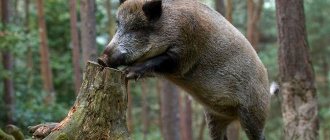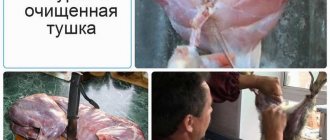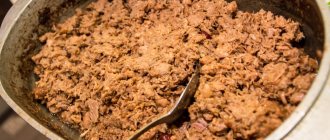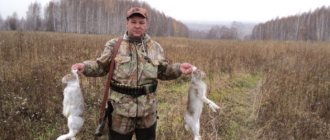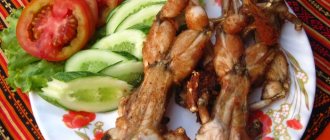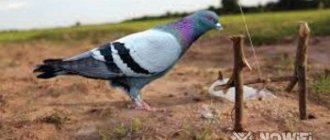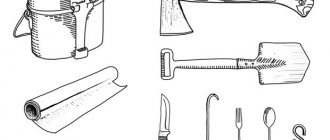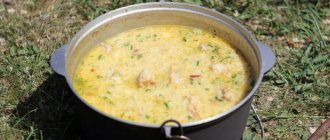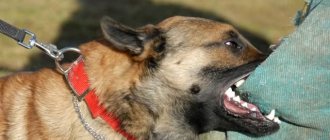- April 24, 2020
- Cooking
- Tatiana Truzhennikova
The Russian consumer in most cases prefers pork meat to other types of product. Pork has gained popularity due to its excellent taste and relative cheapness.
However, in order not to ruin the carcass, it must be cut responsibly. This applies not only to meat processing plants, but also to farms and hunters. There is a certain technology, the origins of which should not be deviated from. Violating the rules can ruin the pork meat.
Knowledge of how to cut a wild boar is primarily needed by a farmer or hunter. Wild or domestic animals must be butchered promptly after slaughter, otherwise the meat will lose its taste and the shelf life will be sharply reduced. It doesn’t matter what kind of habitat the animal has - a forest or a household, butchering of the carcass is carried out according to the same pattern. But there are some nuances that need to be paid attention to.
General principles of cutting up carcasses
In order to understand how to properly cut a wild boar, you need to understand what tools should be used.
If we are talking about wild pigs, which are shot in a forest area, then the carcass must be cut up immediately. If this rule is neglected, the meat will quickly deteriorate. Subsequently, the broth from it will be cloudy.
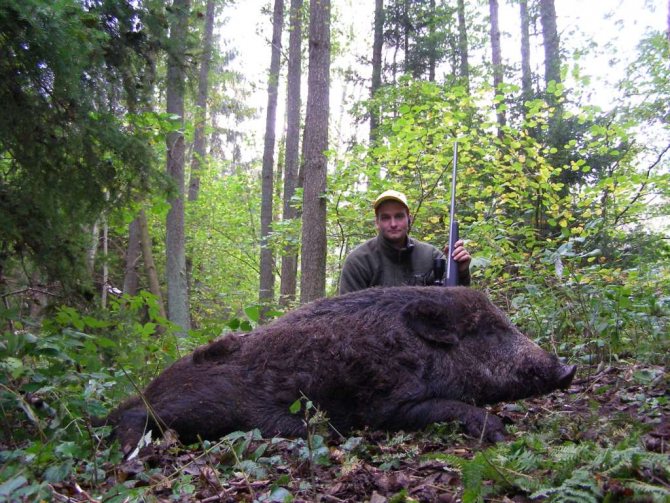
If it is not possible to cut up a wild boar carcass on site, then it must at least be bled dry.
A domestically raised wild boar is prepared with special care before slaughter. There is a special pen in which the animal is kept without food for at least a day. The womb will be freed from feces. Thanks to this procedure, the purity of the meat will noticeably increase. As for a wild animal, such preparation is impossible. Therefore, cutting the wild boar must be done extremely carefully.
Bleeding the carcass
Once the animal has been hit, the first thing to do is to bleed the carcass. If you neglect this and do not quickly bleed it, the meat will spoil much faster.
To allow as much blood as possible to drain from the body, the large blood vessels in the neck must be cut. This should not be done with a wide cut along the neck; this spoils the skin, which is of great value to hunters. For this purpose, a puncture is made in the lower part of the neck with a sharp long knife. You need to try to cut the blood vessels located there and remove the knife, causing as little damage to the skin as possible.
The carcass of the animal is placed so that the puncture site is lower than the rest of the body, that is, the front part of the body should be lower than the back. This will help reduce bleeding time.
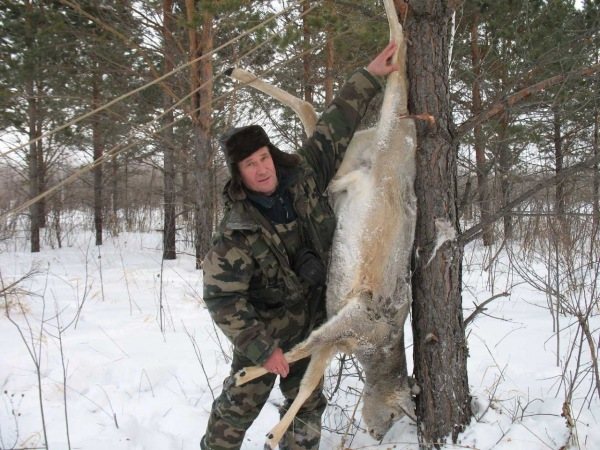
Bleeding carcasses while hunting and at home
Before cutting up a wild boar, the carcass of a slaughtered animal must be bled, that is, the blood must be drained. The domestic specimen should be laid on either side. In hunting conditions, the animal is suspended upside down by its limbs; first, they should be spread apart as much as possible.
Then proceed like this:
- any container is placed under the animal’s throat;
- An incision is made in the throat, deep enough to cut an artery called the carotid.
The blood will drain for at least 20 minutes. Depending on the size and age of the boar, the procedure may take more or less time.
Bleeding
“How to butcher a domestic or wild boar?” - the answer to this question is actually not very complex technology. But first of all, as we found out, the blood must be drained from the animal’s carcass. To get rid of it, a domestic or wild boar should be turned on its side or hung from a tree by its hind legs. In the latter case, the animal’s legs on the branch are spread as far apart as possible.
place a container under the animal’s neck;
make a deep incision in the throat, cutting the carotid artery.
Having completed these two operations, then you just need to wait until the blood flows out of the carcass. This process usually takes about 20 minutes.
Skinning a wild animal carcass
Experienced hunters have many versions about how wild boar is butchered. There are craftsmen who are able to skin an animal carcass using only a knife in 15-20 minutes. Naturally, such skills require practice.
- After the carcass is bled, it is necessary to separate the skin. To do this, cuts are made around the joints above the hooves of the four legs.
- A long incision is made along the inside of the thighs between one incision around the joint of the back leg and a second.
- Next, cut the skin along the peritoneum to the neck, bringing the blade to the lower lip.
- Using a sharp knife, carefully remove the skin.
- The final stage of how to properly cut a wild boar is separating the head from the body. Only after this the front hooves are removed. To do this, some use a hatchet, others have adapted to a knife. You should not remove the hind hooves, since the carcass is suspended from them. They are separated at the very end.
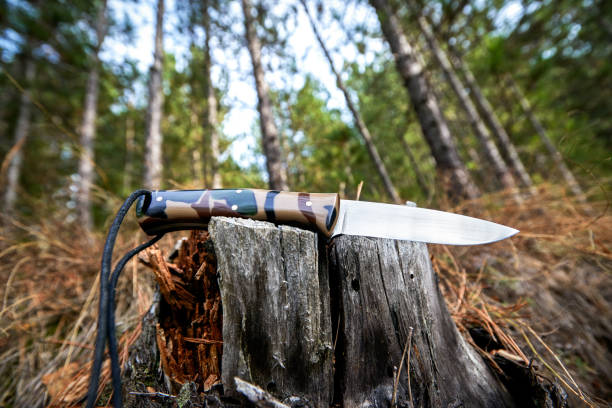
Gutting a wild boar after skinning
Before butchering a wild boar in the forest, it is worth knowing that gutting is carried out with the utmost care so that the liver remains intact. When bile gets on meat, its taste becomes bitter.
- By making a cut along the shoulder blade, the front leg is separated from the carcass along the joint. Then the second one.
- The cartilage of the pelvis is cut, an incision is made almost to the peritoneum.
- The hind legs are cut down to the joints.
- The peritoneum is cut along the body to the neck.
- The intestines are removed, then the offal is removed. Kidneys and liver are suitable for food. The heart is often cooked. However, light ones are not for everyone. Most often they are thrown away or given to dogs.
- After extraction, the internal organs suitable for food are placed in cold water in a previously prepared container.
Domestic boar after slaughter
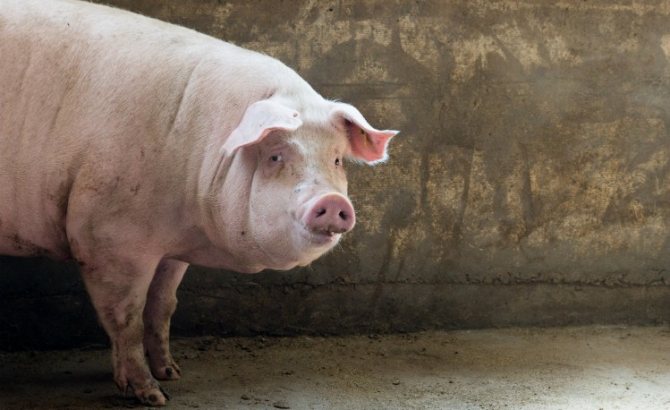
Butchering a domestic pig has some differences. Before cutting a wild boar at home, the skin is not removed. This is due to the lack of wool. Therefore, immediately after the blood has drained, the skin begins to be cleaned.
To make the process as simple as possible, the carcass is placed on any surface. The knife blade is placed perpendicular to the plane, and soft long movements are made along. Some people prefer to burn out the stubble using a gas burner.
How to butcher a wild boar at home
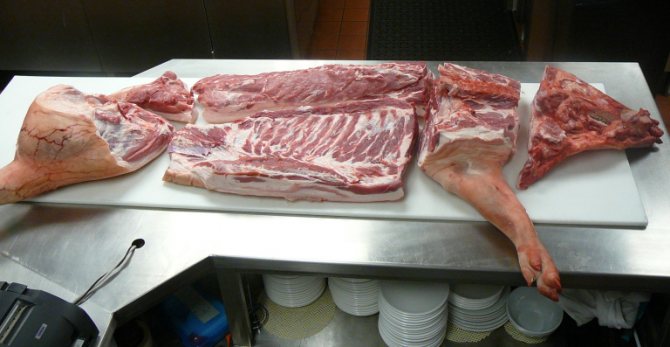
Domestic boar is skinned in several stages.
Stage 1:
- initially the carcass is beheaded;
- make incisions around the anus;
- the intestine is stretched out, it is ligated using a sling;
- the genitals are removed;
- an incision is made along the peritoneum;
- the ribs are separated from the backbone, the entrails suitable for food are removed (they are immediately placed in the cold);
- The carcass is divided into a couple of parts and placed in the refrigerator for a day.
Stage 2:
- After each half of the carcass has been cooled, one is placed on a flat surface.
- You need to find the end of the spine next to the ham. This is necessary for the subsequent separation of the rear part of the animal.
- Along the contour of the thigh, the abdomen is cut to the joint, which is called the hip.
- A hacksaw is usually used to cut the spine.
- Half the carcass is turned over so that the belly is on top. Then it will be easy to separate the front leg. The pork leg is pulled up and a deep cut is made in the meat down to the joint. Continuing to pull the leg up, wait for the joint to diverge. Next, a cut is made.
- Then the loin is cut off - the flesh on the bone.
- The next step is to divide half the carcass into the neck, lard and brisket.
- The same operation is carried out with the second half.
If the meat has not been aged, it is sent for maturation. Then it can be sold or prepared.
What you need to know about meat after cutting
Immediately after cutting, you should not start preparing meat dishes. It will acquire specific taste qualities only after it ripens.
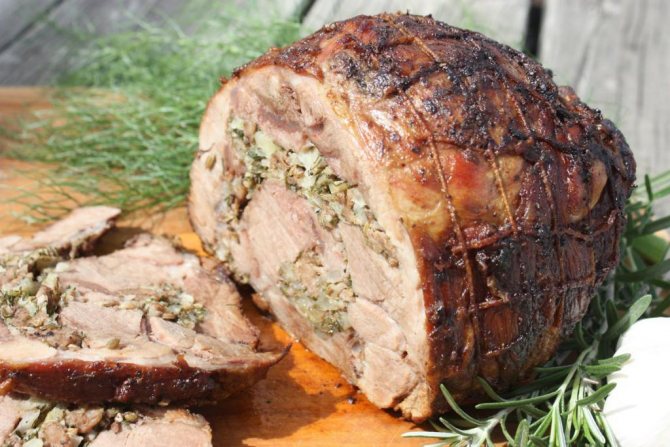
The pork needs to undergo some changes. In the first hours, usually from two to four after cutting, there is no pronounced taste or smell. This type of meat is called fresh meat. After about three hours, rigor rigor occurs. Well, after two or three days, the rigor rigor resolves.
After about three days, the meat quickly acquires a soft consistency because the process of muscle relaxation ends. The meat becomes juicy and tender. Those processes that affect the taste and aroma of the product continue for 12-14 days.
Pig slaughter most often occurs in winter, when temperatures reach sub-zero temperatures. This is due to the fact that this period is unprofitable for keeping the animal. Weight gain is slow, and a lot of food is consumed.
A wild boar cannot be shot while it is hunting. Domestic boar should not be slaughtered for more than a month after castration. This is due to the release of hormones into the blood. Such meat will become harmful for human consumption.
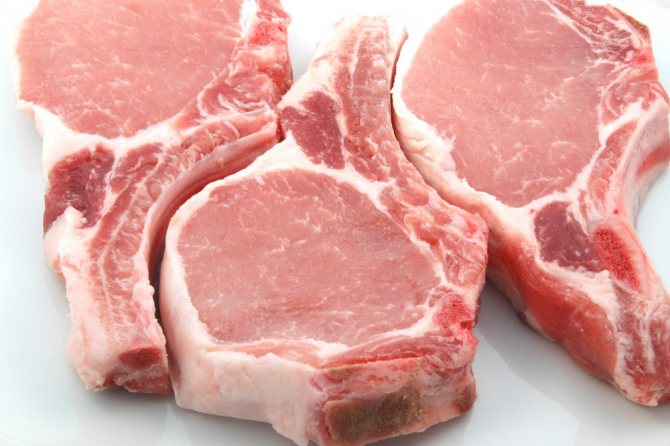
What you should know
Thus, we found out how to cut a wild boar. But what to do next with the chopped pieces?
Boar meat, both domestic and wild, should not be consumed immediately after slaughter. This product becomes tasty only after aging and “ripening”. After slaughter, boar meat undergoes the following processes of structure change:
the first 2-4 hours - fresh meat of a soft consistency with a not very well expressed taste and smell;
after 3 hours - rigor;
after 2-3 days after slaughter - resolution of rigor rigor.
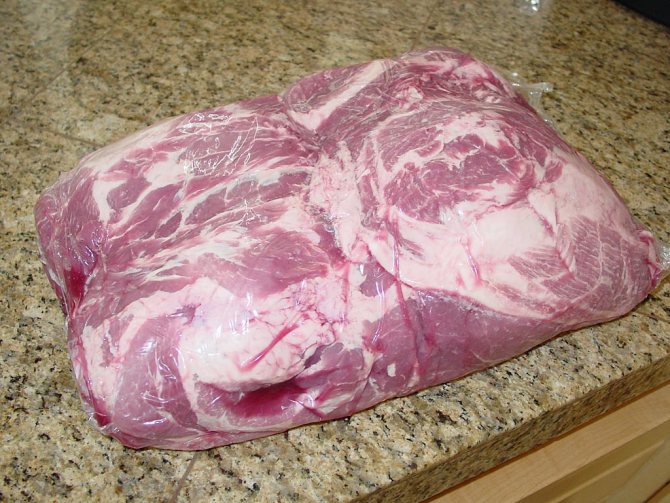
Usually on day 3, the muscles of the carcass relax and the meat suddenly becomes soft. The product aged in this way acquires a juicy and tender consistency. Subsequently, the processes that shape the flavor and aromatic qualities of meat continue for approximately another 14 days.
Tracking a wild animal and killing it with a well-aimed shot requires skill and dexterity. But an experienced hunter knows that this is only part of the hunt, while another integral part of this hunt is the fate of the carcass of the killed animal.
When a shot-hit animal falls to the ground, a person has only a few hours to take care of the meat, skin, entrails, horns and hooves. If the carcass is not cut up during this time, it will begin to deteriorate irreversibly, the meat will no longer be suitable for food, and the skin will begin to rapidly lose its quality. To prevent this, every hunter must know not only how to kill an animal, but also how to properly cut up a carcass.
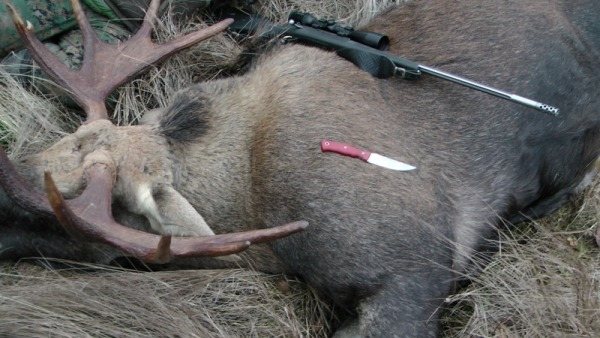
Types of butchering of domestic pigs
In all corners of the planet, people eat pork. It has a lot of advantages. To ensure that the product is not spoiled, it is necessary to take a serious approach to the technology of cutting up the animal carcass after slaughter. Several types of cutting are used in world practice:
- Russian;
- German;
- English;
- American
Regardless of the type of meat cut, the best parts are considered to be meat that is cut from the areas of least mobility. For example, the neck is a particularly valuable product. Consumers do not particularly value meat cut from the bottom of the carcass because toughness predominates here.
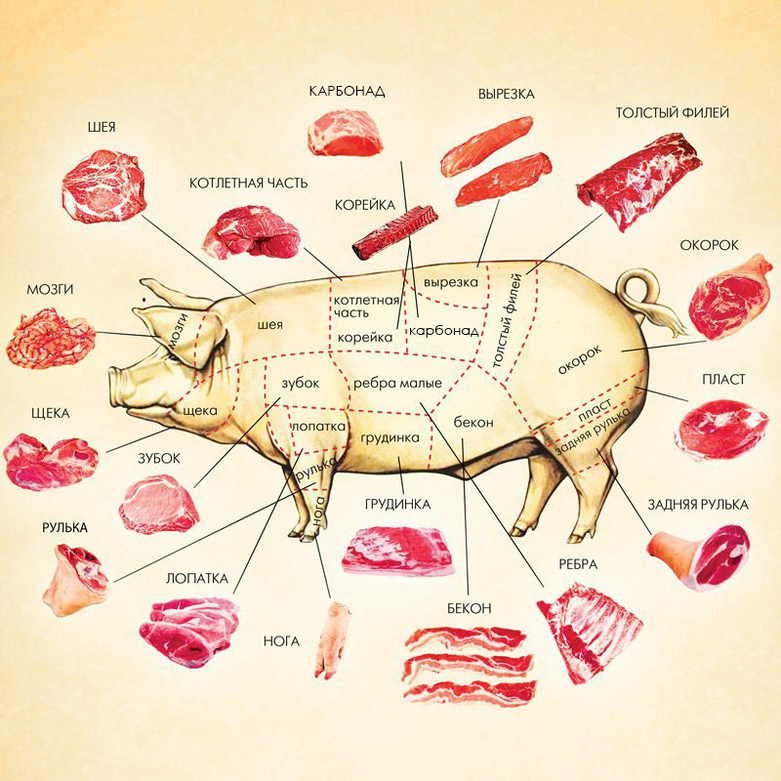
It is important to remember that the boar differs from the pig in the presence of a prostate gland. It doesn’t matter whether the animal is wild or domestic, if you touch this gland when cutting a carcass, the smell spreads throughout the meat very quickly.
Thus, knowing the cutting schemes, the basic principles of gutting and skinning, you can cut up a wild boar yourself. A little practice will add clarity to the movements, which will speed up the process.
Cutting rules
Be sure to take note: it is best to quickly hand over the carcass of a wild boar, as well as other large animals, to a procurement point. If you do not know how to properly freeze and dry the skin, you will not be able to sell the animal for a lot of money. But sometimes such an opportunity is not available. In this case, you need to generously sprinkle the inside of the removed skin with salt.
How much salt is required? Calculate 40% of the total weight of the boar. After this, roll the skin 3-4 times with the wool facing out. Over the course of several days, the carcass is thoroughly salted. Now it won't spoil.
According to ancient hunting customs, if a wild boar was caught collectively, then the one who first shot the animal gets its paws. It is customary to divide the common meat equally. Each hunter takes an equal share of the flesh and the rest of the body. It is also recommended to leave a share for the huntsman. This is done at least out of respect for such a person.
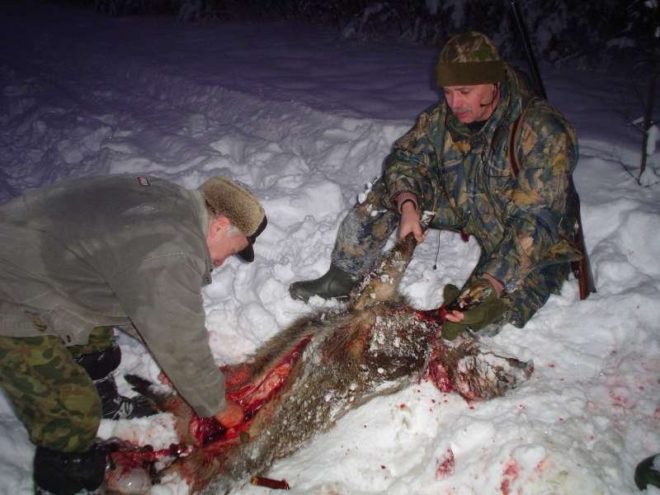
These are the main features of cutting a wild boar. Now you know in what order this needs to be done. It will be great if the recommendations received are useful to you more than once.
